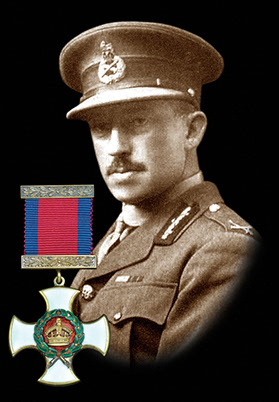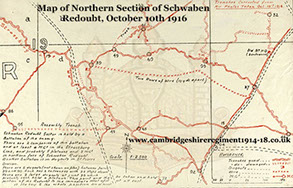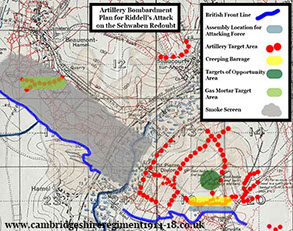
Who Were
The Cambs
The Cambs
at War
1/1st Btn 1914-1919
1914 - 1/1st Overview
1915 - 1/1st Overview
1915 - St Eloi
1915 - Fosse Wood
1916 - 1/1st Overview
1916 - The Schwaben
1916 - St Pierre Divion
1917 - 1/1st Overview
1917 - St Julien
Insignia, Medals & Books
Remembering The Cambs
Biographies
About Us &
This Site
The Cambridgeshires and the Schwaben Redoubt - October 14th & 15th 1916
Part 2 - Riddell's Plan
The order, received by Riddell on October 11th, that the Cambridgeshires were next to assault the remaining German positions of the Schwaben Redoubt, did not come as a surprise, nor was he unprepared for it. After watching the failed attack in early September, Riddell had been contemplating how to successfully take the resilient German fortification. The scenes of slaughter on the gentle slope and the following swift German counter attacks led him to study the battlefield in great detail. By the time he was told it was their turn to try next he had already formed the basis for his attack and he took this plan to his superiors.
Riddell, a keen eyed and shrewd officer, was well schooled in the art of warfare and a seasoned soldier who had fought in the Boer War. In early 1914 he had been selected to be an instructor at Sandhurst and in 1915 he was posted to the 3rd Army School in Flixecourt. Importantly however, Riddell was not governed by his pre-war military training and paid great attention to new methods and technology. This willingness to evolve and not remain bound by old and out of date methods was a key factor in Riddell’s successes during his wartime career. For his proposed attack on the Schwaben, Riddell was not only intending to use new concepts and strategies but also to break the mould of British offensive infantry tactics.
The plan that Riddell presented to his superiors expanded on their intended attack. The first key change that he made was to increase the attacking force by adding a second battalion to the assault (the 4th/5th Black Watch). In doing this he split the objective into two halves, proposing that the Cambridgeshires took the left section and the Black Watch the right. Alongside this increase in size of the assaulting force, Riddell wanted to quickly bring up heavier firepower in the form of four Vickers machine guns of the 118th Machine Gun Company. These machine gunners were to take up positions in the captured redoubt and act as the backbone of the defence. Additional support in repairing and constructing the defences, as well as bringing up supplies, was to come from the men of the 234th Field Coy, Royal Engineers and the Pioneers of the 13th Battalion, Gloucestershire Regiment.
Having witnessed first hand, on at least three separate occasions, how the Germans defended the Schwaben, Riddell knew that to succeed the redoubt must be isolated from the other nearby German positions. Even with the recent British territorial gains in and around the Schwaben, the remaining German positions would support each other with machine gun and rifle fire in the event of a British attack. It was also imperative that communication lines from the redoubt be severed and any sources of likely reinforcement or counter attack be cut off. To do this Riddell laid out a very detailed artillery plan using a large number of guns in a variety of calibres.
Riddell was keen to make use of a new artillery technique that was beginning to be developed, called the creeping barrage. This consisted of a curtain of artillery shells, fired in a slowly advancing wall, across an area where the troops were to advance. The attacking soldiers would move up over no-man’s-land close behind this exploding wave of shells. The infantry would then be in place to immediately occupy the enemy trench after the barrage had passed over it, leaving the defenders no time to react. This technique was not without its serious dangers, especially as the method was relatively new. Timing was critical between the artillery and the infantry the barrage had to advance at a rate that would not leave the infantry stranded in no-man’s-land. There was also a real risk of casualties among the friendly infantry from any shells landing short or from a badly timed barrage. But Riddell knew if planned and orchestrated properly it would keep his infantry safe from the German machine gunners.
Alongside the creeping barrage (to be fired by two divisions worth of 18-prs) Riddell also planned for additional 18-prs, 4.5” Howitzers, 60-prs and even several 6” Howitzers to fire on the Schwaben itself and numerous other neighbouring positions. One of the 39th Division’s 18-pr batteries was not included in the pre-planned bombardment, Riddell specifying that they were to work closely with an artillery observer and fire on any targets of opportunity moving up from St Pierre Divion. After the creeping barrage had finished these guns were then tasked with counter battery fire against any enemy artillery positions or were to add to the bombardment of nearby positions. Further indirect fire support would be in the form of Trench Mortars and Vickers machine guns, all of which were tasked with targeting the likely routes for supplies and reinforcements.
To complete the isolation of the redoubt, Riddell planned for a massive smoke screen, starting in the Ancre valley and stretching across to the west around Hamel. This screen would block the view of the Germans on the far side of the valley around Beaumont Hamel. It would also keep the Germans focused on the possibility of an additional attack in the area of the smoke. In conjunction with the smoke and the artillery bombardment the plan included the use of an unusual mortar bomb. Around 100 experimental gas-filled 2” mortar rounds were made available from the Canadians and Riddell planned for these rounds to add to the bombardment of the notorious German strong point called Y Ravine.
For any assaulting force one of their most vulnerable times was just before the attack. Once in the confines of the assembly positions the attackers would be densely packed together. If observed by the enemy, this concentration of troops would not only give away the imminent attack, but could also easily be annihilated by enemy artillery fire before the assault had even started. To avoid this and keep his men as safe as possible, Riddell introduced two elements to his plan. He proposed the construction of a new, partially concealed, assembly trench line to give his infantry the best possible start point. He also asked for canvas screens to be erected along the route the men would be taking as they moved up to the assembly line. This would hopefully keep the men hidden from the view of neighbouring German positions that may then alert the defenders in the redoubt.
After watching the tenacious German shock troops counter attack and push out any British troops that had previously taken the redoubt, Riddell knew that this would be one of the major issues that he and his men would need to overcome. In order to do this he knew his infantry needed to be in the best possible state after their initial assault. They needed to be well supplied with fresh ammunition and heavier support weapons and they needed to be in a good strong defensive position. In his proposed plan he paid extra attention to making sure the supplies would be in place for when they were needed and detailed when the engineers and pioneers would be required. He specified that the heavy Vickers machine guns and even a Stokes Mortar be moved up with the third and fourth waves of attacking infantry. These heavy support weapons would establish themselves quickly in key strong points in the captured position. Plans were also drafted for the evacuation of wounded although this matter was to be handled in more detail by the Divisional RAMC officers.
The ever-astute Riddell saw that a major issue in defending a captured position such as the Schwaben, was that the enemy knew every inch of the ground as they had occupied it for years. The enemy artillery knew the exact layout of the defences and key positions could easily and quickly and accurately targeted. The safest approach routes for any counter attacks would be well known, as would any likely position for machine guns. Armed with this knowledge and the support of accurate artillery fire, a swift German counter attack could easily evict the British infantry as they struggled to organise the defence.
To tip the balance back in the favour of his men and negate these advantages for the German counter attackers, Riddell planned for a bold and unconventional move. Once his men had cleared the trenches some of them were to push on around 100 yards beyond the German position. They were then to form defensive posts in a rough line using the numerous shell craters, which could be turned into strong defensive positions. Some of these outposts would then be linked together to form a new crude trench in front of the captured position. This new line and posts would be unknown to the Germans, resulting in the German artillery fire passing safely over Riddell’s men who could then catch any counter attack by surprise.
At this stage of the War nearly every major attack started with a prolonged artillery bombardment to “soften” up the enemy and cut barbed wire. There was however a huge disadvantage to this, it gave away any element of surprise. Attacks also tended to take place around the same time of day with early morning being the standard time. Riddell wanted his attack to catch the enemy by surprise so, once again, he took the bold and unconventional route and specifically avoided the use of any preliminary bombardment. He also specified the attack should commence at the unusual time of 4.10pm.
To help protect each flank of the assaulting infantry the plan included an additional small scale assault on the trenches just to the west of the redoubt by men of the 1/6th Cheshires (another of the 118th Brigade's infantry battalions). To the east units from the neighbouring 25th Division would also put in several attacks to the right of Stuff Redoubt.
Riddell’s proposed plan went far beyond the expectations of his superiors. He had more than doubled the number of infantry, vastly increased the number of artillery guns and brought in numerous other support arms. His planned called for a great deal of cooperation with neighbouring units, especially in regards to artillery. Time however was short with less than 48 hours until the attack. The level of detail and understanding of the problems at hand in Riddell’s proposal impressed his superiors. They quickly set about getting approval and support for the scheme. Over the next 24 hours further planning led to some small adjustments to the original plan and, after liaising with the neighbouring 25th Division, the time for the attack was adjusted and now set for 3.17pm on October 13th…
Part 3 - Misfortune & Postponement
Back to the top of the page.
The Cambridgeshires & the Schwaben Redoubt
Part 1 - Background & History of the Redoubt
Part 2 - Riddell's Plan
Part 3 - Misfortune & Postponement
Part 4 - The Assault
Part 5 - Strong Points & Riddell Trench
Part 6 - Gallant Deeds
Part 7 - Counter-Attacks and Relief

"Ted" Riddell, circa 1918.

This site went live on the 14th February 2015 to mark 100 years since the 1/1st Cambs went off to war.
WE WILL REMEMBER THEM
Email us: cambsregt@gmail.com
Copyright 2015, 2016, 2017, 2018, 2019 by Felix Jackson. The information and images on this site should not be reproduced without prior permission.

